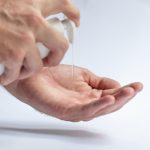Looking to repair a tear in your favorite fabric? Ever wondered how to use Loctite Super Glue Power Flex Control Gel on fabrics? Look no further!
This quick guide will show you the simple steps to achieve a strong and flexible bond on your fabric. With clear instructions and helpful tips, you'll be mastering fabric repairs in no time.
Let's dive in and learn how to make those fabric fixes with ease.
Key Takeaways
- Properly prepare the fabric surface by removing dirt and debris, and cleaning heavily soiled fabric if necessary.
- Test the glue on a small area to ensure compatibility with the fabric and avoid stiffness or visible residue.
- Ensure proper adhesion by cleaning the fabric surface with isopropyl alcohol, removing any residues that could hinder bonding.
- Allow sufficient drying time based on fabric type and glue amount, considering the impact of temperature and humidity on drying time and adhesive strength.
Preparing the Fabric Surface
How thoroughly should you clean the fabric surface before applying Loctite Super Glue Power Flex Control Gel?
Proper surface cleaning is crucial for ensuring the effectiveness of Loctite Super Glue Power Flex Control Gel on fabrics. Begin by gently removing any dirt, dust, or debris from the fabric using a soft brush or cloth. It's important to ensure that the fabric is completely free from any contaminants that could interfere with the adhesive bond.
Once the surface is free from visible dirt, consider using a mild detergent to clean the fabric more thoroughly, especially if it's heavily soiled. After washing, rinse the fabric thoroughly to remove any soap residue, and allow it to dry completely before applying the glue.
When using Loctite Super Glue Power Flex Control Gel on fabrics, it's essential to consider fabric compatibility. While the glue is suitable for use on a wide range of fabrics, it's always best to test it on a small, inconspicuous area first to ensure compatibility and adhesion. This simple step can help prevent any unexpected damage or discoloration to the fabric.
Applying Loctite Super Glue Power Flex Control Gel
Once the fabric surface is thoroughly cleaned and free from any contaminants, how do you precisely apply Loctite Super Glue Power Flex Control Gel to ensure a strong and lasting bond?
First, ensure that the fabric is compatible with super glue by checking the manufacturer's recommendations. Once verified, apply a small, controlled amount of the gel to one of the fabric surfaces. The gel's precision applicator allows for accurate placement without any mess.
Gently press the two fabric surfaces together, ensuring an even distribution of the adhesive. Hold the bonded surfaces firmly for the recommended setting time to allow the glue to cure.
It's crucial to avoid excessive glue application, as this can lead to a stiff or visible residue on the fabric. Additionally, be cautious not to apply the glue too close to the fabric's edge to prevent seepage.
Following these precise application steps will result in a strong and durable bond, ensuring that your fabric project withstands the test of time.
Ensuring Proper Adhesion
To ensure that the Loctite Super Glue Power Flex Control Gel adheres properly to fabrics, there are a few key points to consider.
First, you'll want to properly prepare the fabric by ensuring it's clean and free from any oils or residue.
Then, when applying the adhesive, it's important to use the right techniques to ensure even coverage and a strong bond.
Fabric Preparation Tips
To achieve proper adhesion when using Loctite Super Glue Power Flex Control Gel on fabrics, thoroughly clean the fabric surface with isopropyl alcohol or a similar solvent. This step is crucial for ensuring that the glue bonds effectively to the fabric.
Here are some fabric preparation tips to help you achieve the best results:
- Check Fabric Compatibility: Ensure that the fabric is compatible with super glue and won't be damaged by the adhesive.
- Remove Any Residues: Make sure the fabric surface is free from any residues, such as dust, oil, or previous adhesives, that could hinder the bonding process.
- Use Isopropyl Alcohol: Wipe the fabric surface with isopropyl alcohol to remove any dirt, grease, or other impurities that could affect adhesion.
- Allow Fabric to Dry: After cleaning, allow the fabric to thoroughly dry before applying the super glue to ensure optimal adhesion.
Adhesive Application Techniques
Clean the fabric surface with isopropyl alcohol before applying the Loctite Super Glue Power Flex Control Gel to ensure proper adhesion.
Ensure that the fabric is completely dry before applying the adhesive.
Apply a small amount of the gel to one surface and firmly press the fabric together.
Hold the bonded pieces in place for at least 60 seconds to allow the adhesive to set.
For larger fabric repair areas, consider using clamps or heavy objects to hold the pieces together while the adhesive bonds.
It's important to follow the manufacturer's instructions for application and drying times.
Additionally, avoid stretching or stressing the bonded area until the adhesive has fully cured.
These adhesive bonding techniques will help ensure a strong and durable bond for your fabric repair needs.
Bond Strength Testing
Test the bond strength of the adhesive on the fabric by applying pressure to the bonded area.
To ensure proper adhesion and fabric compatibility, follow these steps:
- Apply firm and even pressure to the bonded area using your fingertips.
- Check for any signs of the adhesive giving way or the bond breaking.
- If the bond holds, carefully increase the pressure to simulate stress on the fabric.
- Inspect the bond for any signs of weakening or separation.
Allowing Sufficient Drying Time
When using Loctite Super Glue Power Flex Control Gel on fabrics, it's important to consider the fabric's absorption capabilities. Ensure the fabric is clean and dry before applying the glue to maximize adhesion.
Additionally, take into account the impact of temperature and humidity on the drying time for the best results.
Fabric Absorption Considerations
Ensure that the fabric fully absorbs the Loctite Super Glue Power Flex Control Gel and allow sufficient drying time. Different fabric types absorb glue differently, impacting drying times. Follow these steps for optimal results:
- Fabric Types: Consider the type of fabric you're working with, as different materials absorb glue at varying rates.
- Glue Penetration: Understand how the glue penetrates the fabric, as this affects the drying time.
- Even Application: Apply the Loctite Super Glue Power Flex Control Gel evenly to ensure consistent absorption.
- Patience: Allow sufficient drying time based on the specific fabric type and the amount of glue applied.
Temperature and Humidity Impact
To achieve optimal results when using Loctite Super Glue Power Flex Control Gel on fabrics, you need to allow for sufficient drying time in varying temperature and humidity conditions. The impact of weather on the drying time and adhesive strength is crucial to consider. In high humidity, the drying time may be extended, while low humidity can accelerate the drying process. Similarly, extreme temperatures can affect the bonding process. It's important to ensure that the fabric is compatible with the glue and that the environmental conditions are suitable for the adhesive to cure effectively. Below is a table outlining the general impact of temperature and humidity on drying time and adhesive strength:
| Temperature | Humidity | Drying Time | Adhesive Strength |
|---|---|---|---|
| High | High | Extended | Strong |
| High | Low | Normal | Strong |
| Low | High | Extended | Normal |
| Low | Low | Accelerated | Normal |
Testing the Bonded Area
After allowing the glued area to set for at least 24 hours, carefully examine the bond by gently pulling on the fabric.
When testing the bonded area, follow these steps:
- Gentle Tug: Apply a small amount of force by gently pulling on the fabric to test the strength of the bond. If the bond holds and the fabric remains intact, it indicates a successful bond.
- Visual Inspection: Examine the bonded area closely to look for any signs of separation, discoloration, or weakening. A strong bond should show no visible signs of damage.
- Stretch Test: Gently stretch the fabric around the bonded area. A good bond will retain the fabric's elasticity and shouldn't cause any tearing or separation at the bonded spot.
- Wash Test: If the fabric is washable, consider washing the item according to the fabric's care instructions. Inspect the bonded area after washing to ensure that the bond remains intact and unaffected by the washing process.
Performing these tests will help ensure the effectiveness of the bond and the compatibility of Loctite Super Glue Power Flex Control Gel with the fabric.
Additional Tips for Successful Fabric Repairs
For successful fabric repairs, employ a gentle touch when handling the bonded area to avoid any potential damage.
When using Loctite Super Glue Power Flex Control Gel on fabrics, it's crucial to consider fabric compatibility. Certain fabrics may not bond well with the adhesive, so always test a small, inconspicuous area first to ensure compatibility.
Once you've confirmed that the fabric is suitable for bonding, proceed with application precision. Apply a small amount of the gel to one surface and press the fabric together firmly, ensuring that the glue is evenly distributed. Take care to avoid using excessive glue, as this can lead to stiffness or discoloration in the fabric.
After bonding, allow ample time for the glue to set and cure completely before handling the repaired fabric.
Safety Precautions and Clean-up
When using Loctite Super Glue Power Flex Control Gel on fabrics, ensure proper ventilation and wear protective gloves to avoid skin contact with the adhesive. Here are some safety precautions and clean-up tips to consider:
- Proper Ventilation: Work in a well-ventilated area to minimize inhalation of fumes and ensure that the adhesive cures properly.
- Protective Gear: Wear protective gloves and, if necessary, a mask to prevent skin contact and inhalation of fumes.
- Disposal: Dispose of any used or excess adhesive carefully according to local regulations. Some adhesives may require special disposal methods.
- Cleaning Supplies: Have cleaning supplies such as acetone or nail polish remover on hand to clean up any accidental spills or to remove excess adhesive from surfaces.
Frequently Asked Questions
Can Loctite Super Glue Power Flex Control Gel Be Used on Delicate Fabrics Such as Silk or Lace?
Yes, Loctite Super Glue Power Flex Control Gel can be used on delicate fabrics such as silk or lace. Apply a small amount and avoid excessive squeezing to prevent seepage. It's compatible with different fabric types when used carefully.
Will the Adhesive From the Glue Leave a Visible Residue on the Fabric?
You won't have any residue concerns using Loctite Super Glue Power Flex Control Gel on fabrics. It's designed to work with delicate materials like silk or lace without leaving a visible mark. Its compatibility with fabric makes it a reliable choice.
How Should I Store the Loctite Super Glue Power Flex Control Gel to Ensure Its Longevity?
To ensure the longevity of your Loctite Super Glue Power Flex Control Gel, store it in a cool, dry place away from direct sunlight. This will preserve its adhesive properties and ensure it's ready for any fabric repair needs.
Can This Glue Be Used to Repair Waterproof or Water-Resistant Fabrics?
Yes, you can use Loctite Super Glue Power Flex Control Gel to repair waterproof or water-resistant fabrics. It's effective for repairing leather, denim, and using on outdoor and performance fabrics. Just follow the instructions for best results.
Is It Safe to Wash Fabrics Repaired With Loctite Super Glue Power Flex Control Gel in a Washing Machine?
You can safely wash fabrics repaired with Loctite Super Glue Power Flex Control Gel in a washing machine. This ensures fabric safety and long-term durability of the repair, making it convenient for your daily use.
- Does Chiffon Fabric Stink - July 15, 2025
- Does Chiffon Fabric Affect the Economy - July 15, 2025
- Does Cotton Fabric Have a Nap - July 15, 2025







